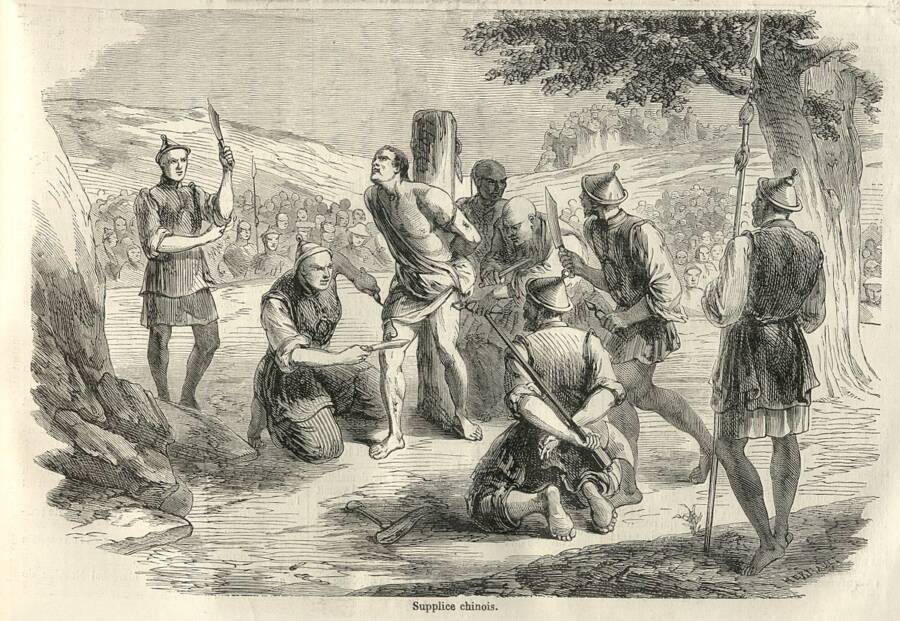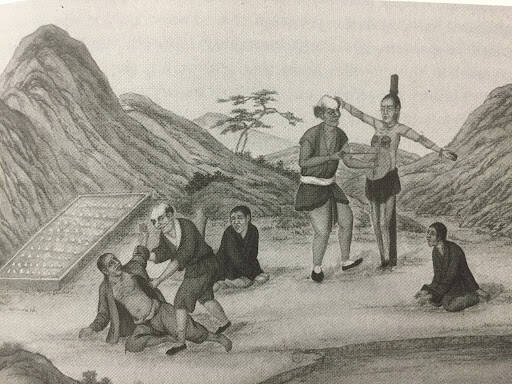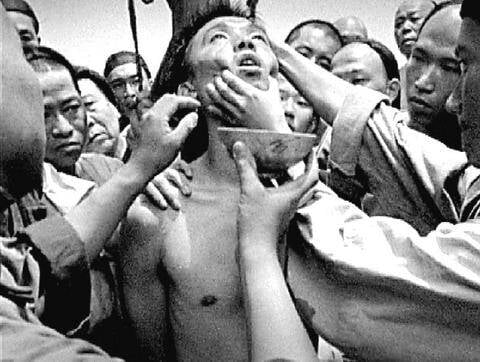The cut-by-cut torture method known as lingchi may have been in use for hundreds of years in Eastern Asia.

Public DomainA French illustration showing the 1858 lingchi execution of a French missionary, Auguste Chapdelaine, in China.
From the Tang dynasty until the final years of the Qing, a form of capital punishment set itself apart from the rest for its particularly cruel and brutal practices.
The ancient Chinese torture tactic known as lingchi — which translates loosely to “slow slicing,” “lingering death,” or “death by a thousand cuts” — was a method of execution from the seventh century up until 1905, when it was officially outlawed.
As the name implies, lingchi was a drawn-out and brutal process, wherein an executioner would deliver justice to various lawbreakers by administering a series of cuts to the skin.
Unlike most execution styles, which aim to kill sooner rather than later, the aim of lingchi was a long, slow punishment, intended to see how many cuts a person could withstand before dying.
How Was Lingchi Performed?

Public DomainAn illustration of Fu Zhuli’s exection by lingchi.
The procedure was fairly straightforward, and called for executioners to tie the condemned person to a wooden post, unable to move or break free from their binds.
Some accounts, like those from George Ernest Morrison, the author of the 1895 book An Australian in China detailed the person receiving opium prior to the execution.
“The prisoner is tied to a rude cross: he is invariably deeply under the influence of opium. The executioner, standing before him, with a sharp sword makes two quick incisions above the eyebrows, and draws down the portion of skin over each eye, then he makes two more quick incisions across the breast, and in the next moment he pierces the heart, and death is instantaneous. Then he cuts the body in pieces; and the degradation consists in the fragmentary shape in which the prisoner has to appear in heaven.”
As detailed above, the executioner would administer cuts to bare flesh, usually starting at the chest, where the breast and surrounding muscles were methodically removed until the bare ribs were almost visible. Next, the executioner would make his way over to the arms, cutting away large portions of flesh and exposing tissue in an excruciating bloodbath before moving down to the thighs, where he would repeat the process.
By this point, the victim would have likely died. Executioners would collect their severed limbs and place them inside of a basket.
As Chinese law didn’t actually specify any particular method of delivery, the act of lingchi tended to vary by region. Some accounts report that the punished were dead in less than 15 minutes, while other cases apparently went on for hours, forcing the accused to withstand up to 3,000 cuts.
These details would depend on the depth of each incision, as well as the skill level of the executioner and the severity of the crime.
Officials would sometimes take pity on those charged with lesser offenses, limiting their time spent suffering. Families who could afford to would often pay to have their condemned relatives killed right away, assuring that the first cut would be the last one, and sparing them from hours of brutal torture.
Who Fell Victim To The Brutal Torture Method?

PHGCOM / Wikimedia CommonsThe execution of Joseph Marchand in 1835 by lingchi.
Not everyone was subject to die in such a cruel and unusual way, as lingchi was reserved for only the worst crimes, such as treason, mass murder, patricide, and matricide. However, anyone for whom the traditional methods of punishment did not apply were, unfortunately, sentenced to meet their maker in the cruelest of ways in these public executions.
While many ancient accounts of lingchi had likely been mythologized, fitting a sensationalized Western narrative which depicted the “savage” practices of the then-mysterious Chinese, one case provided photographic evidence of such cruelty.
French travelers caught the execution of Fou Tchou-Li by lingchi on film. He was convicted in 1905 of murdering his master, a Mongolian prince, and was the last known execution by lingchi before the Chinese government banned death by a thousand cuts only two weeks later.
Other than Fou Tchou-Li, other examples of lingchi come from European missionaries in China. One such rumored example was Auguste Chapdelaine, a French missionary who worked in China during the mid 1800s.
In 1856, Chinese officials arrested Chapdelaine and sentenced him to death for disobeying laws barring Christians from coming into specific Chinese regions. Chapdelaine was subject to cage torture and ultimately died of suffocation after executioners hung him by his neck and slowly removed the floorboards under his feet. An 1858 article by Harper’s Weekly claimed Chapdelaine died by lingchi, but historic accounts disprove this.
An additional account of lingchi comes from Joseph Marchand, another French missionary. Sent to Vietnam, Marchand supported the overthrow of Vietnamese ruler Emperor Minh Mạng in favor of a Catholic leader My Duong. As punishment for his role in the uprising, Marchand faced lingchi. Pope John Paul II canonized Marchand in 1988.
Lingchi As Cultural Phenomenon

Chen Cheh JehScene from 2002 Lingchi — Echoes of a Historical Photograph, a fictional account of the torture method.
The horror of lingchi comes not only from the painful act itself, but its meaning for those subjected to it. According to the Confucian ideal of filial piety, or loyalty to one’s family, altering of the body meant that the victim would not be “whole” in the afterlife.
In total, the act was both a type of public humiliation and a death sentence both literally and spiritually. That explains why it was only reserved for heinous or rebellious offenses.
The history of lingchi dates back to the earliest days of China, with the first accounts of the act coming from China’s earliest emperors.
Lingchi was highly controversial from its conception. While some rulers frequently used the method, others appealed for its illegalization.
Despite the controversy, it continued as a practice as late as 1936. The last man to face lingchi was Ling Fushun, a Chinese Communist Party soldier captured by Republican forces.
Since then, the grizzly practice has fallen out of favor. Now, it thankfully only makes appearances in history textbooks and popular culture.
Of course, the ancient Chinese were not alone in devising particularly painful forms of punishment. Don’t believe us? Check out the practice of defenestration, then discover the ten worst execution methods ever devised. Finally, read up on the five worst ways to die.






